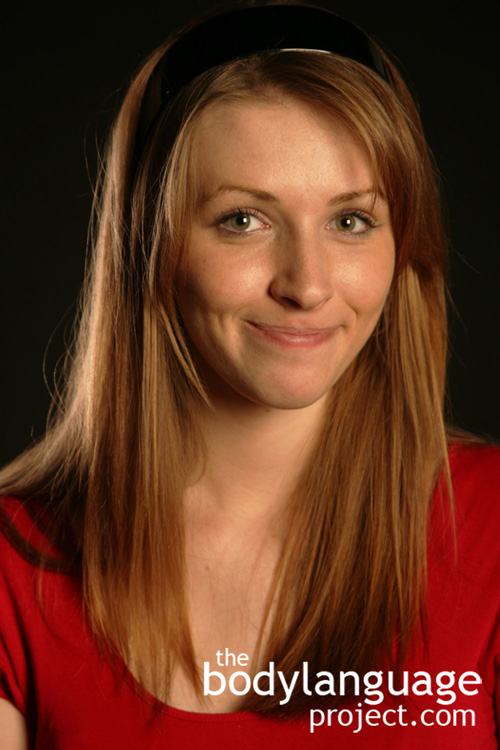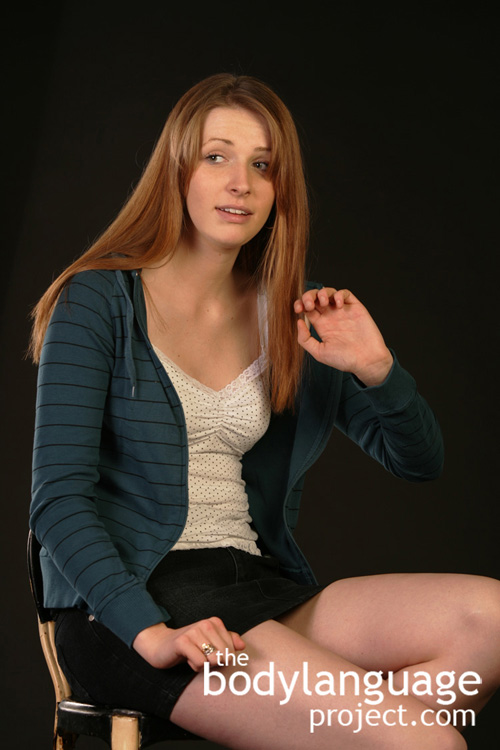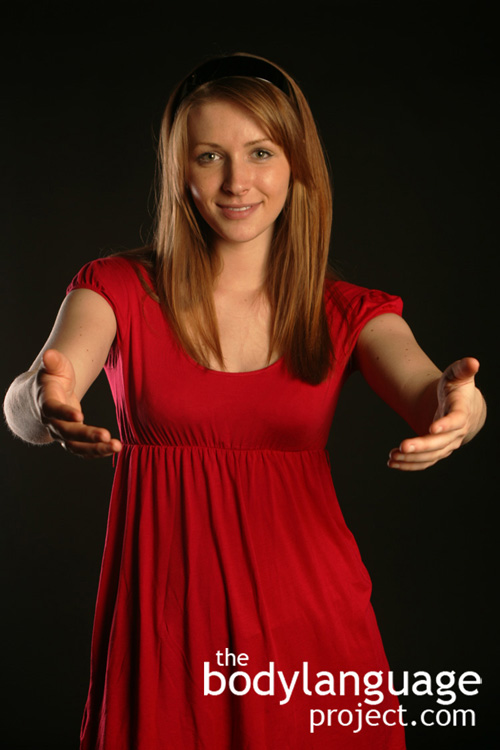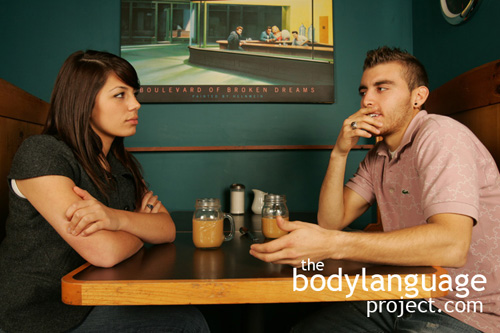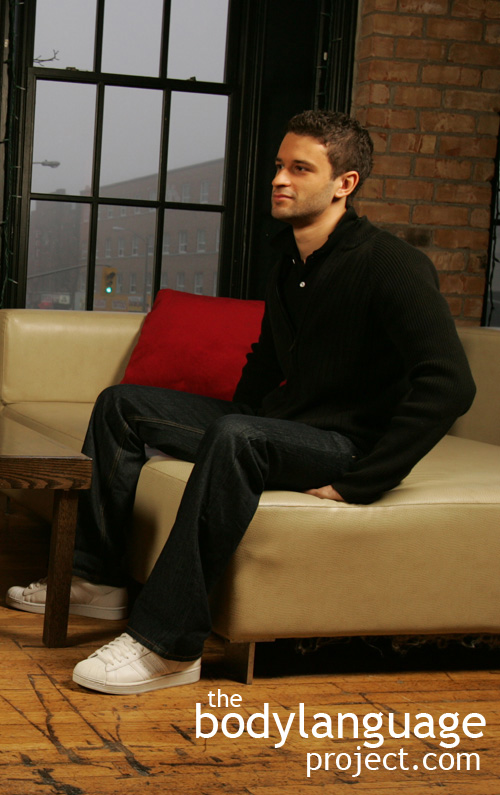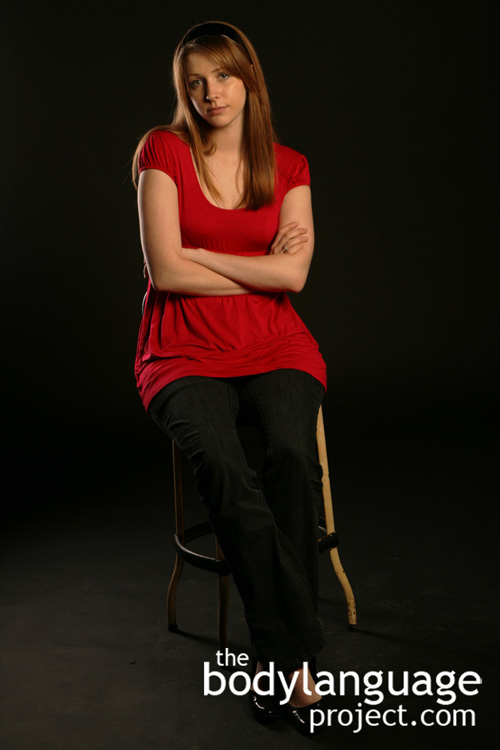Body Language of The Artificial Smile or Fake Smile
Synonym(s): Pretend Smile, Fake Smile, Phony Smile, False Smile.
Description: A feigned smile where the orbicularis oculi muscles surrounding the eyes play no part and the lips are only stretched across the face with the help of the zygomatic muscles surrounding the mouth. The tell-tale cue is the fake smile is the lack of “crows feet.” The teeth are often bared, with a tense jaw and the lips show asymmetry.
In One Sentence: A fake smile, where the eyes play no part, shows others that one is not sincere in their happiness.
How To Use it: Use the fake smile to appease others whilst remaining polite. This is the smile used to fake your way through a photograph. The fake smile is often naturally occurring and you may wish to do it to show that you are not really on board with another person or their ideas. A fake smile is a great way to show people that you can be cooperative, but also apathetic to the situation at hand.
Context: General
Verbal Translation: “I acknowledge you are there, but I’m not exactly brimming with joy to see you.” I’m putting on a fake smile just to appease other people so they leave me alone.”
Variant: See Fear Smile, Friendly Smile, Frown (the) or Downturned Smile, Honest Smile or Duchenne Smile, Jaw Drop Smile, Nervous Smile, Polite Smile (the), Uneven Smile Or Lopsided Smile, Upper Lip Smile.
Cue In Action: a) A group of friends flash an artificial smile while posing for a photograph. b) When two strangers pass on the sidewalk, they each perform a fake smile to acknowledge each other. c) While being caught in a lie, the lips of the liar are stretched across his face to cover up his stress. d) It was obvious her statement wasn’t to be believed because it was followed by a fake smile.
Meaning and/or Motivation: Fake smiles are appeasement gestures done to show other people that we’re not threat and mean no harm, but that we aren’t experiencing real joy or happiness. Thus, the fake smile is not genuine.
Artificial smiles can also indicate that a person isn’t telling the truth. For example, the statement “He’s a great boss, I’d switch companies and follow him anywhere if he left” that is followed by a fake smile indicates that the entire statement is false.
Cue Cluster: The fake smile is a sand-alone cue and need no supporting cues to have meaning. Fake smiles can be accompanied by averted eyes, arm crossing, arms in pockets and various other closed body language.
Body Language Category: Appease, Nonthreatening body language, Stressful body language.
Resources:
Abel, Ernest L. and Michael L. Kruger. Smile Intensity in Photographs Predicts Longevity. Psychological Science. 2010. 21(4): 542-544.
Seder, J. Patrick and Shigehiro Oishi. Intensity of Smiling in Facebook Photos Predicts Future Life Satisfaction. Social Psychological and Personality Science. 2012. 3(4): 407-413.
http://bodylanguageproject.com/articles/facebook-smile-predicts-life-satisfaction/
Colonnesi, Cristina; Susan M. Bogels; Wieke de Vente and Mirjana Majdandzic. What Coy Smiles Say About Positive Shyness in Early Infancy. Infancy. 2013. 18(2): 202–220. ISSN: 1525-0008 print / 1532-7078 online
DOI: 10.1111/j.1532-7078.2012.00117.x
http://bodylanguageproject.com/articles/nonverbal-meaning-coy-smiles-infants/?preview=true
Cashdan, Elizabeth. Smiles, Speech, and Body Posture: How Women and Men Display Sociometric Status and Power. Journal of Nonverbal Behavior. 1998. 22(4): 209-228.
Centorrino, Samuele, Elodie Djemai, Astrid Hopfensitz, Manfred Milinski, Paul Seabright. Honest Signaling in Trust Interactions: Smiles Rated as Genuine Induce Trust and Signal Higher Earning Opportunities. Evolution and Human Behavior DOI:
dx.doi.org/10.1016/j.evolhumbehav.2014.08.001.
http://bodylanguageproject.com/articles/smile-great-gain-smiling-key-negotiation/
Ekman, P., Davidson, R., & Friesen, W. V. (1990). The Duchenne smile: Emotional expression and brain physiology II. Journal of Personality and Social Psychology, 58, 342–353.
Ekman, P., & Friesen, W. V. (1982). Felt, false and miserable smiles. Journal of Nonverbal Behavior, 6, 238–252.
Ekman, P., Friesen, W. V., & O’Sullivan, M. (1988). Smiles when lying. Journal of Personality and Social Psychology, 54, 414–420.
Ekman, P., Roper, G., & Hager, J. C. (1980). Deliberate facial movement. Child Development, 51, 886–891.
Frank, M. G., & Ekman, P. (1993). Not all smiles are created equal: The differences between enjoyment and nonenjoyment smiles. Humor: International Journal of Humor Research, 6, 9–26.
Frank, M. G., Ekman, P., & Friesen, W. V. (1993). Behavioral markers and recognizability of the smile of enjoyment. Journal of Personality and Social Psychology, 64, 83–93.
Fairbairn, Catharine E.; Michael A. Sayette; Odd O. Aalen and Arnoldo Frigessi. Alcohol and Emotional Contagion: An Examination of the Spreading of Smiles in Male and Female Drinking Groups. Clinical Psychological Science. 2014. DOI: 2167702614548892
http://bodylanguageproject.com/articles/alcohol-social-lubricant-male-smiles/
Gueguen, Nicolas. Weather and Smiling Contagion: A Quasi Experiment With the Smiling Sunshine. Journal of Nonverbal Behavior. 2013. 37:51–55. DOI 10.1007/s10919-012-0140-y
http://bodylanguageproject.com/articles/weather-smile-not-contagion-smile-linked-weather-conditions/
Gosselin, Pierre; Reem Maassarani; Alastair Younger and Mélanie Perron. Children’s Deliberate Control of Facial Action Units Involved in Sad and Happy Expressions. Journal of Nonverbal Behaviour. 2011. 35:225–242. DOI 10.1007/s10919-011-0110-9.
http://bodylanguageproject.com/articles/childrens-control-facial-actions-improve-age-create-accurate-emotional-expressions/
Gunnery, Sarah D.; Judith A. Hall and Mollie A. Ruben. The Deliberate Duchenne Smile: Individual Differences in Expressive Control. Journal of Nonverbal Behavior. 2013. 37:29–41. DOI 10.1007/s10919-012-0139-4
http://bodylanguageproject.com/articles/can-probably-fake-honest-smile-deliberate-duchenne-smile/
Golle, Jessika; Fred W.; Mast and Janek S. Lobmaier. Something to Smile About: The Interrelationship Between Attractiveness and Emotional Expression. Cognition and Emotion, 2014. 28:2: 298-310. DOI: 10.1080/02699931.2013.817383.
http://bodylanguageproject.com/articles/smiles-arent-just-cameras/
Guéguen, N. The Effect Of A Woman’s Smile On Men’s Courtship Behavior. Social Behavior and Personality. 2008. 36(9): 1233-1236.
http://bodylanguageproject.com/articles/how-women-can-use-a-simple-smile-to-attract-men/
Guéguen, N., & Fischer-Lokou, J. (2004). Hitchhiker’s Smiles And Receipt Of Help. Psychological Reports. 94: 756-760.
Grandey, Alicia A. ; Fisk, Glenda M. ; Mattila, Anna S. ; Jansen, Karen J. ; Sideman, Lori A. Is “service with a smile” enough? Authenticity of positive displays during service encounters. Organizational Behavior and Human Decision Processes. 2005. 96(1): 38-55.
Harker, L. A., & Keltner, D. (2001). Expressions of positive emotion in women’s college yearbook pictures and their relationship to personality and life outcomes across adulthood. Journal of Personality and Social Psychology, 80, 112–124.
Hertenstein, Matthew J.; Carrie A. Hansel; Alissa M. Butts and Sarah N. Hile. Smile Intensity In Photographs Predicts Divorce Later In Life. Motiv Emot. 2009; 33:99-105
DOI 10.1007/s11031-009-9124-6
http://bodylanguageproject.com/articles/small-smiles-predicts-divorce/
Harker, L., & Keltner, D. (2001). Expressions Of Positive Emotion In Women’s College Yearbook Pictures And Their Relationship To Personality And Life Outcomes Across Adulthood. Journal of Personality and Social Psychology, 80(1), 112–124. doi: 10.1037/0022-3514.80.1.112.
Krumhuber, E., Manstead, A., & Kappas, A. Temporal Aspects of Facial Displays in Person and Expression Perception: The Effects of Smile Dynamics, Head-tilt, and Gender. Journal of Nonverbal Behavior. 2007. 31(1), 39-56.
http://bodylanguageproject.com/articles/slow-onset-smile-best/
Johnson, Kareemj. ; Waugh, Christiane. ; Fredrickson, Barbaral. Smile to see the forest: Facially expressed positive emotions broaden cognition. Cognition & Emotion. 2010. 24(2): 299-321.
Johnston, L., Miles, L., & Macrae, C. N. (2010). Why are you smiling at me? Social functions of enjoyment and non-enjoyment smiles. British Journal of Social Psychology, 49, 107–127.
Krumhuber, Eva ; Likowski, Katja ; Weyers, Peter. Facial Mimicry of Spontaneous and Deliberate Duchenne and Non-Duchenne Smiles. Journal of Nonverbal Behavior. 2014. 38(1): 1-11.
Krause, Michael W. and Teh-Way David Chen. A Winning Smile? Smile Intensity, Physical Dominance, and Fighter Performance. Emotion. 2013. 13 (2): 270–279. DOI: 10.1037/a0030745
http://bodylanguageproject.com/articles/smile-lose-smile-intensity-predicts-fighting-ability
Krumhuber, Eva G.; Manstead and Antony S. R. Can Duchenne smiles be feigned? New evidence on felt and false smiles. Emotion. 2009. 9 (6): 807-820.
http://bodylanguageproject.com/articles/can-fake-real-smile-practice/
Krumhuber, Eva; Antony S. R.; Manstead; and Arvid Kappas. Temporal Aspects of Facial Displays in Person and Expression Perception: The Effects of Smile Dynamics, Head-tilt, and Gender. Journal Nonverbal Behavior. 2007; 31: 39-56.
DOI 10.1007/s10919-006-0019-x
http://bodylanguageproject.com/articles/head-tilt-and-slow-onset-smile-nonverbals-trust-attraction-dominance-and-flirting-a-brief-report/
Lewis, David. 1999. The Secret Languages of Success: Using Body Language to Get What You Want. BBS Publishing Corporation.
Lockard, J. S., McVittie, R. I., & Isaac, L. M. (1977). Functional Significance Of The Affiliative Smile. Bulletin of the Psychonomic Society, 9, 367-370.
Labroo, Aparna A.; Anirban Mukhopadhyay; Ping Dong. Not Always the Best Medicine: Why Frequent Smiling Can Reduce Wellbeing. Journal of Experimental Social Psychology. 2014. 53:156-162.
http://bodylanguageproject.com/articles/why-too-much-smiling-can-be-bad-for-you/
Mehu, Marc ; Grammer, Karl ; Dunbar, Robin I.M. Smiles when sharing. Evolution and Human Behavior. 2007. 28(6): 415-422.
Mehu, M., Little, A. C., & Dunbar, R. I. M. (2007). Duchenne smiles and the perception of generosity and sociability in faces. Journal of Evolutionary Psychology, 5, 133–146.
Okubo, Matia; Akihiro, Kobayashi and Kenta Ishikawa. A Fake Smile Thwarts Cheater Detection. Journal of Nonverbal Behaviour. 2012. 36:217–225. DOI 10.1007/s10919-012-0134-9
http://bodylanguageproject.com/articles/fake-till-make-cheaters-fake-smile-make-lies-difficult-detect/
Prkachin, Kenneth M. ; Silverman, Barbara E. Stone, Arthur A. (editor) Hostility and Facial Expression in Young Men and Women: Is Social Regulation More Important Than Negative Affect? Health Psychology. 2002. 21(1): 33-39.
Quadflieg, Susanne ; Vermeulen, Nicolas ; Rossion, Bruno. Differential Reliance on the Duchenne Marker During Smile Evaluations and Person Judgments. Journal of Nonverbal Behavior. 2013. 37(2): 69-77.
Reed, Lawrence Ian; Katharine N. Zeglen and Karen L. Schmidt. Facial Expressions as Honest Signals of Cooperative Intent in a One-Shot Anonymous Prisoner’s Dilemma Game. Evolution and Human Behavior. 2012. 33: 200-209.
http://bodylanguageproject.com/articles/facial-expressions-honest-signals-smiling-contempt-predict-cooperation-defection/
Reissland, Nadja; Brian Francis, James Mason, Karen Lincoln. Do Facial Expressions Develop before Birth? August 2011. 6(8): e24081. doi:10.1371/journal.pone.0024081.g001
http://bodylanguageproject.com/articles/the-cry-and-laugh-face-in-the-human-fetus/
Surakka, V., & Hietanen, J. K. (1998). Facial and emotional reactions to Duchenne and non-Duchenne smiles. International Journal of Psychophysiology, 29, 23–33.
Thibault, Pascal ; Gosselin, Pierre ; Brunel, Marie – Lise ; Hess, Ursula. Children’s and Adolescents’ Perception of the Authenticity of Smiles. Journal of Experimental Child Psychology. 2009. 102(3): 360-367.
Tidd, K., & Lockard, J. (1978). Monetary Significance Of The Affiliative Smile: A Case For Reciprocal Altruism. Bulletin of the Psychonomic Society, 11, 344-346.
Vazire, S., Naumann, L.P., Rentfrow, P. J., and Gosling, S. D. (2009). Smiling reflects different emotions in men and women. Behavioral and Brain Sciences, 32:5, 403–405.
http://bodylanguageproject.com/articles/smiling-reflects-different-emotions-men-women/
Vigil, J. M. (2009). A socio-relational framework of sex differences in the expression of emotion. Behavioral and Brain Sciences, 32, 375–428.
Walsh, D. G., & Hewitt, J. (1985). Giving Men The Come-On: Effect Of Eye Contact And Smiling In A Bar Environment. Perceptual and Motor Skills, 61, 873-874.

